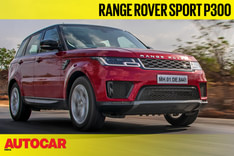2018 Range Rover Sport facelift India review, test drive
Small changes on the outside and big changes on the inside make the Range Rover Sport more modern and desirable.
Published on Aug 01, 2018 03:29:00 PM
57,141 Views
Follow us on


What is it?
It’s an updated version of Range Rover’s mid-level luxury SUV, the Sport, that’s now priced between Rs 93.82 lakh and Rs 1.64 crore (ex-showroom), and sits below the full-size super-luxury SUV known only as ‘Range Rover’ (Rs 1.66-3.61 crore). It’s a bit confusing, admittedly, and to complicate matters more, January 2018 saw the launch of the Range Rover Velar (Rs 80.92 lakh-Rs 1.41 crore), another ‘mid-level’ offering. Then you have the latest seven-seat Land Rover Discovery (Rs 71.38 lakh to Rs 1.08 crore), launched in 2017, which though not as luxurious, is more spacious, practical and affordable. Still, you have to admit, they’re all in the same ballpark.
So the facelifted Range Rover Sport has a trickier job justifying its existence than it did a few years ago, but the good news is there are still plenty of reasons for you to love it.

For one, there are the sharper looks, mainly thanks to the new full-LED headlamps, which, on top-spec variants, have ‘Pixel LED’ adaptive beams. Then there are the new bumpers, front and rear, and these really attractive 21-inch wheels; remember when 21s were considered excessive? Well, now they suit this size of SUV just right. Apart from that, though, not much else has changed, and the Range Rover Sport remains a well-proportioned vehicle.
| Land Rover Range Rover Sport Price, Mileage, Specifications, Features and Variants | |
|---|---|
| Brand | Land Rover |
| Model Name | Range Rover Sport |
| Land Rover Range Rover Sport Price | ₹ 1.67 - 3.40 crore |
| Land Rover Range Rover Sport Range/Mileage | NA |
| Land Rover Range Rover Sport Specifications | SUV | 5 doors | 5 seats View All Specs |
| Land Rover Range Rover Sport Features | LED headlight | 13.1-inch Touchscreen display | 8 airbags View All Features |
| Land Rover Range Rover Sport Variants | Petrol P400 Dynamic HSE 3.0 | Diesel D350 Dynamic HSE 3.0 | Petrol-Hybrid P460e Autobiography 3.0 View All Variants |
What’s it like inside?
Inside, things are largely the same too. You still get generous front seats with thick cushioning that give you a commanding view forward. Quality is generally superb, and I really like some of the materials used in this particular car’s cabin. For instance, the window switches (placed, in true Range Rover fashion, atop the window sill) are now finished in a cool brushed metal, which feels significantly more luxurious than the rather basic old plastic switches, and a lot of the control buttons (mirror adjusters and the steering controls, for instance) now use touch-sensitive glossy black surfaces that light up when you use them. They don’t always click correctly at first touch and take some getting used to, but aesthetically, it’s just sublime.

The big news, however, comes in the form of the brand new infotainment system – InControl Touch Pro Duo – which made its debut on the Velar. It’s based around a pair of touchscreens (rather than just one, as before) and the first thing you notice is how much brighter, smoother and crisper the graphics are; proper HD stuff. The upper screen functions as before – music, navigation, phone, apps and settings, while the lower one is dedicated to climate control, seat heating and drive modes. The top screen can be tilted forward to avoid glare but is all-touch, and what I like is that they’ve put a pair of physical rotary dials on the lower screen so you don’t have to look down to use basic functions. The best part is that these dials are context-sensitive, and change based on the function at hand. The third screen is the digital instrument cluster (previously the preserve of the big Range Rover and the Jaguar XJ) and it too is much brighter and of a higher resolution this time. But for all its visual modernity, it’s a shame JLR didn’t take the opportunity to integrate Apple CarPlay and Android Auto into this system.
What’s it like to drive?
The Sport is available with four engines – supercharged V6 and V8 petrols, a turbo-diesel V8 and the car we’re driving, the base turbo-diesel V6. What’s more, this is not the full-fat 300hp/700Nm ‘SDV6’ you get in the Jaguar XJ, but instead the ‘TDV6’ with 258hp and 600Nm of torque. Not that you’ll ever feel any shortage of power; this car has a claimed 0-100kph time of 7.7sec and it feels that quick too. For a diesel V6, it sounds rather good as well, and Maserati’s sonorous V6 is the only other that comes to mind in this regard. Okay, the eight-speed automatic gearbox does sometimes fumble a little bit during kickdown and that detracts from the sensation of outright responsiveness, but build up the power smoothly and it feels properly brisk. One cannot pretend that it shrinks this massive SUV into something compact, certainly not this base V6 diesel engine, but you’ll be surprised by how effortlessly it moves along.

And while on the subject of shrinking down this SUV’s dimensions, it’s important to remember that ‘Sport’ was always a bit of a misnomer with this car. Yes, in relation to the bigger Rangie, it is a bit sporty, but if you want an SUV of this size that handles, you’d do better with a Porsche Cayenne or BMW X5. The Range Rover Sport has tidy body control for something this large sitting on air springs, yes, but the steering is quite relaxed and doesn’t egg you on to push harder. What’s more, that air suspension, in the interest of the ‘Sport’ name, seems to have been set up a little firmer than necessary, and combined with those 21-inch wheels and 275-section tyres, does make for quite a lumpen ride.
But an area where few other luxury SUVs could dare come near to a Range Rover is off-road ability, and that hasn’t changed. In fact, we chose to shoot this test drive in a monsoon-ravaged region just outside Mumbai, and let’s just say that there are not many other cars of this price we’d dare to take there, with the roads in those conditions, but the Range Rover just sailed over it without hesitation. Another new bonus for this 2018 facelift is the addition of radar-based features like adaptive cruise control and a collision warning system, and there are even other sensor-based safety features like lane-keeping assist.

Should I buy one?
Perhaps there is such a thing as ‘too much of a good thing’. By offering each of its models with so many variants and such a wide price range, Land Rover has created so much overlap in its model range, picking the right model can get quite confusing. The ‘big’ Range Rover remains the choice for ultimate luxury, the Land Rover Discovery is the one to choose for practicality and versatility, and the Velar is now the ‘sporty’ one in the range with better on-road dynamics. So what of this Range Rover Sport? Well, it’s the do-it-all model that gets you a little bit of everything. It’s not perfect, and as with all Range Rovers, the price might seem a bit high for what it offers on paper, but it still offers what it always has – imposing looks, proper luxury, unbeatable off-road ability, and the prestige that comes with the Range Rover badge.
Tech Specs 
Copyright (c) Autocar India. All rights reserved.












 Price
Price Engine
Engine Transmission
Transmission Body
Body Dimensions
Dimensions
Comments
Member Login
Personal Details
No comments yet. Be the first to comment.